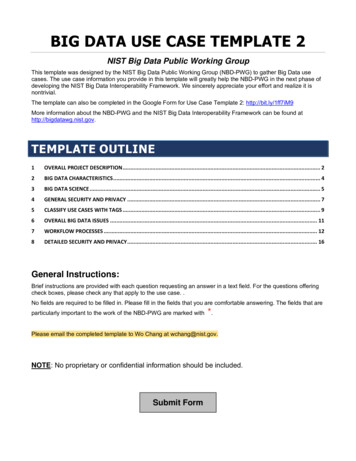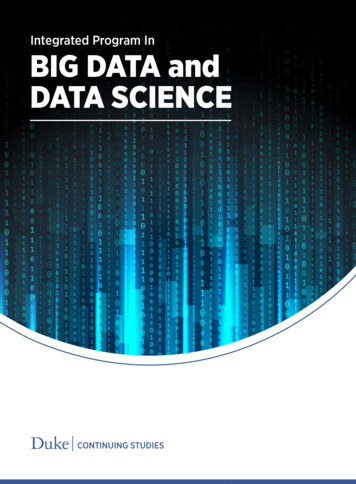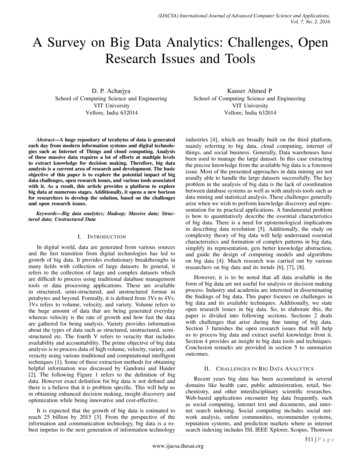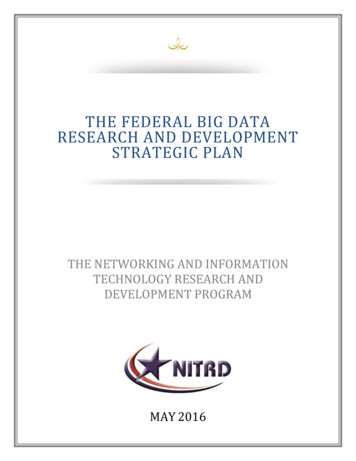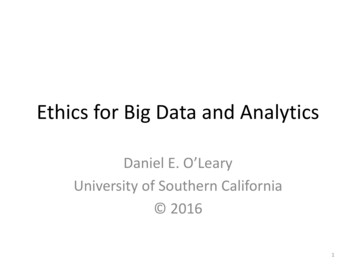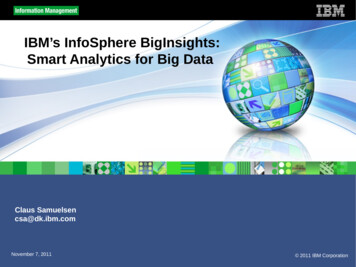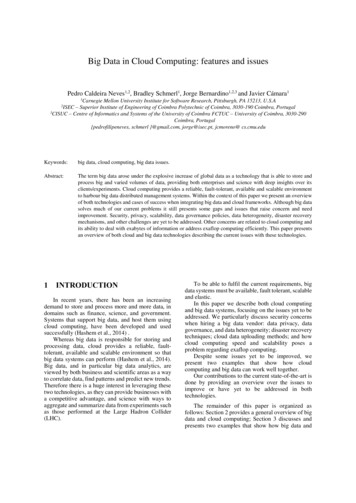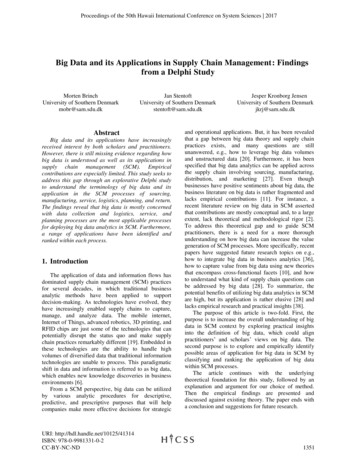
Transcription
Proceedings of the 50th Hawaii International Conference on System Sciences 2017Big Data and its Applications in Supply Chain Management: Findingsfrom a Delphi StudyMorten BrinchUniversity of Southern Denmarkmobr@sam.sdu.dkJan StentoftUniversity of Southern Denmarkstentoft@sam.sdu.dkAbstractBig data and its applications have increasinglyreceived interest by both scholars and practitioners.However, there is still missing evidence regarding howbig data is understood as well as its applications insupply chain management (SCM). Empiricalcontributions are especially limited. This study seeks toaddress this gap through an explorative Delphi studyto understand the terminology of big data and itsapplication in the SCM processes of sourcing,manufacturing, service, logistics, planning, and return.The findings reveal that big data is mostly concernedwith data collection and logistics, service, andplanning processes are the most applicable processesfor deploying big data analytics in SCM. Furthermore,a range of applications have been identified andranked within each process.1. IntroductionThe application of data and information flows hasdominated supply chain management (SCM) practicesfor several decades, in which traditional businessanalytic methods have been applied to supportdecision-making. As technologies have evolved, theyhave increasingly enabled supply chains to capture,manage, and analyze data. The mobile internet,Internet of Things, advanced robotics, 3D printing, andRFID chips are just some of the technologies that canpotentially disrupt the status quo and make supplychain practices remarkably different [19]. Embedded inthese technologies are the ability to handle highvolumes of diversified data that traditional informationtechnologies are unable to process. This paradigmaticshift in data and information is referred to as big data,which enables new knowledge discoveries in businessenvironments [6].From a SCM perspective, big data can be utilizedby various analytic procedures for descriptive,predictive, and prescriptive purposes that will helpcompanies make more effective decisions for strategicURI: http://hdl.handle.net/10125/41314ISBN: 978-0-9981331-0-2CC-BY-NC-NDJesper Kronborg JensenUniversity of Southern Denmarkjkrj@sam.sdu.dkand operational applications. But, it has been revealedthat a gap between big data theory and supply chainpractices exists, and many questions are stillunanswered, e.g., how to leverage big data volumesand unstructured data [20]. Furthermore, it has beenspecified that big data analytics can be applied acrossthe supply chain involving sourcing, manufacturing,distribution, and marketing [27]. Even thoughbusinesses have positive sentiments about big data, thebusiness literature on big data is rather fragmented andlacks empirical contributions [11]. For instance, arecent literature review on big data in SCM assertedthat contributions are mostly conceptual and, to a largeextent, lack theoretical and methodological rigor [2].To address this theoretical gap and to guide SCMpractitioners, there is a need for a more thoroughunderstanding on how big data can increase the valuegeneration of SCM processes. More specifically, recentpapers have suggested future research topics on e.g.,how to integrate big data in business analytics [36],how to capture value from big data using new theoriesthat encompass cross-functional facets [10], and howto understand what kind of supply chain questions canbe addressed by big data [28]. To summarize, thepotential benefits of utilizing big data analytics in SCMare high, but its application is rather elusive [28] andlacks empirical research and practical insights [38].The purpose of this article is two-fold. First, thepurpose is to increase the overall understanding of bigdata in SCM context by exploring practical insightsinto the definition of big data, which could alignpractitioners’ and scholars’ views on big data. Thesecond purpose is to explore and empirically identifypossible areas of application for big data in SCM byclassifying and ranking the application of big datawithin SCM processes.The article continues with the underlyingtheoretical foundation for this study, followed by anexplanation and argument for our choice of method.Then the empirical findings are presented anddiscussed against existing theory. The paper ends witha conclusion and suggestions for future research.1351
2. Relevant literatureThis section describes relevant literature to framethe phenomenon in focus in this paper and is organizedinto three subsections. First, the terminology of bigdata is examined. Second, an overview of how existingliterature has discussed the application of big data inSCM context is provided. Finally, the SCM-processframework is related to big data as a potential area ofapplication.2.1 The big data terminologyBig data as a research field is multidisciplinary andrelatively new. Big data is related to businessintelligence and business analytics and has emerged asa separate concept, whereby structured data havebecome unstructured and mobile- and sensor-basedtechnologies allow context-specific analysis [4]. Froma management perspective, big data is a holisticapproach for obtaining actionable insights to create acompetitive advantage [10]. The technologicalcomponent of big data is a prerequisite for its valuegeneration for cases in which information systems areto cope with data collection, data management, anddata utilization with the purposes of supportingbusiness needs, deploying new business models, andimproving existing processes [1]. Big data differs frombusiness analytics in terms of the 5V’s: volume,variety, velocity, veracity, and value [10].For data collection, the characteristics of data havebecome more diverse and include various data formatslike numbers, text, images, and audio [13]. Companieshave been logging their transactions and activitiesresulting in large amounts of internal data. Combiningthis with the Internet of Things has enabled access toexternal data sources that can support the businesseven further, because it creates insights on the businessenvironment at a more granular level [1]. Finally, thepace at which data are captured through advancedtechnologies, i.e., in real time, enables faster responsesto changes as they occur [6].For data management, the structured andunstructured data are to be stored in different systemsin which a transparent IT-infrastructure enables dataintegrations and data sharing [9]. A knowledgediscovery process of data recording, data integration,data analysis, and data presentation are to be deployedand designed to support business purposes anddecision-making [24]. Here various analytic techniquesare to be applied, such as machine learning, datamining, and visualization methods [24]. Intra- andinter-organizational decision support systems rely on anetwork of systems for which governance proceduresassure reliable data analytics [8].For data utilization, knowledge discovered is eitherto support decision-making or to make automateddecision-making [7]. The analytic insights derived canidentify problems and opportunities within existingprocesses, discover explanatory and predictive patternsabout what will happen and provide reasons why, anddetermine the best possible outcome betweenalternatives based on accumulated knowledge [36].Ultimately, utilizing big data should increaseperformance outcomes that, from SCM perspective,can be measured as market, operational, and financialperformance [14,15,16].2.2 Big data applications in SCMThe research domain of SCM is wide and containsseveral technical points of departures such as sourcing,operations management, logistics, finance, and IT.Many definitions of SCM exist, but for the purpose ofthe present paper we rely on the following definitionprovided by Stock and Boyer [32]: “The managementof a network of relationships within a firm and betweeninterdependent organizations and business unitsconsisting of material suppliers, purchasing, productionfacilities, logistics, marketing, and related systems thatfacilitate the forward and reverse flow of materials,services, finances and information from the originalproducer to final customer with the benefits of addingvalue, maximizing profitability through efficiencies,and achieving customer satisfaction.”The application of big data in SCM has beenreferred to as SCM data science [35], predictiveanalytics [28], business analytics, big data analyticsand supply chain analytics [36], which are principallysimilar terminologies for applying advanced qualitativeand quantitative analytics for SCM purposes byutilizing the vast amount of fast moving and diversifieddata available. Overall, there are two distinctapproaches of applying big data; it can either improveexisting processes by focusing on current businessneeds and challenges, or data can be explored to createsellable products and services as new valuepropositions [34]. The potential of big data is notlimited to manufacturing companies; retailers, serviceproviders, healthcare professionals, and governments,among others, also see big data potential [10]. Asurvey of 145 responses shows that large servicecompanies and their supply chains account for moreemployees and higher revenues than manufacturingcompanies; the service supply chains are thereforeimportant to include for SCM theory building [29]. Inthis regard, the supply chain of both physical productsand service deliveries can both benefit from big data.On an overall supply chain level, a structuredliterature review demonstrates that big data can be1352
applied in SCM for operational and developmentpurposes, value discovery, value creation, and valuecapture [2]. Analytic applications are best utilizedacross the supply chain, where analytics operate crossfunctionally and as an integral part of companystrategy [27]. In this context, Sanders [27] identifiessource, make, move, and sell as primary areas ofapplication for big data. For “source” big data may beused to segment suppliers, evaluate sourcing channeloptions, integrate with suppliers, and support suppliernegotiations. For “make” it involves granularperformance reporting, mitigation of location/layout, and workforce analytics. For “move”the application of big data involves ,optimizing, and maintaining vehicles. Finally, for“sell” and marketing purposes, big data enables microsegmentation of customers, the capture and predictionof customer demand and behavior, and price andassortment optimizations. These applications aredefined as conceptual, but also involve some empiricalgrounding. Furthermore, another literature review byWang et al. [36] identifies the application of supplychain analytics in SCM as a strategic asset to beapplied in several operational and strategic SCMprocesses. They establish a five-level analytic maturityframework for analytic applications in SCM. Level oneand two are functional and process-based analytics thatcan be deployed in supply chain operations coveringdemand planning, procurement, production, inventory,and logistics. This involves, for example, aligningsupply and customer demand at stock keeping unitlevel, increasing supply-chain visibility, managing andmitigating risks, managing real-time performance, andoptimizing processes. Furthermore, collaborative,agile, and sustainable analytics as maturity level three,four, and five can be deployed in strategic SCMsettings for strategic sourcing, supply-chain networkdesign, and product design and development. Thisinvolves e.g. evaluation and selection of suppliers, thephysical configuration of the supply chain, and to meetfluctuating demand requirements and utilizing marketopportunities by having a rapid product design process.Further studies include the use of big data in the entireproduct life cycle from the beginning to end of life [17]and within human resources [35].2.3 A SCM process frameworkAs an analytical framework for identifyingapplications of big data in SCM processes, the SupplyChain Operations Reference model (SCOR) has beenchosen for this study. SCOR includes the crossfunctional, high-level, and generic processes plan,source, make, and deliver [31], return, which wasadded later. Previous studies have applied SCOR toevaluate applications of supply-chain analytics forstrategic, tactical, and operational purposes, and arguethat big data indeed have potential to make betterdecisions [30]. However, the application of big data inplan, source, make, deliver, and return has onlypartially been explored [27,36]. Also, SCOR has beenused to determine business analytics and the requiredanalytical supply chain process capabilities likeanalytic capabilities to plan and predict market trendsof products and services [3]. Furthermore, SCOR hasbeen used to determine the effect of business analyticson supply chain performance [22,33]. Given theseprevious studies, SCOR has been proved as aframework for assessing analytic applications in SCM.In addition, given the possibilities that big data have onservice deliveries [10,23], the aspect of serviceprocesses has been added to the analytic frameworkand represents the view of service supply chain as wellas service processes in manufacturing settings.3. MethodologyExtant literature describes big data research withinbusiness environments as being in a nascent phase,during which exploratory and empirical studies areneeded for its theoretical development [11,12]. Inbuilding new theory in an explorative manner, newconstructs and/or relationships are to be discovered [5].To fill the gap between SCM theory and SCMpractices regarding big data and its applications, theDelphi study methodology was chosen due to itsexplorative nature. Linstone and Turoff [18]characterize the Delphi method as “a method forstructuring a group communication process so that theprocess is effective in allowing a group of individuals,as a whole, to deal with a complex problem” [4]. Thestrength of the method is its ability to create consensuson an unexplored topic that lacks empirical evidence[25], which is the case of big data in SCM. The Delphimethod can either be applied for the purpose offorecasting or conceptualizing [21]. With an end goalof ranking applications of big data in SCM, the methodwill be applied to identify the ways in which big data isused in supply chain processes. The study has followedthe traditional Delphi study approach of design,selection of experts, data collection rounds ofbrainstorming, narrowing down of factors and ranking,and finally analysis [21]. Thus, with the ambition ofreaching a more common understanding, an expertpanel was created to provide new insights into thisphenomenon.In a Delphi study, recruitment of appropriateexperts is essential for the validity of the results [26].1353
As big data seems to be most applicable in largercompanies [11], the sampling criteria was that theexperts had to have practical experience with andknowledge about supply chain processes, businessanalytics, and big data, as well as experience workingwith big data in one of the larger organizations inDenmark. Hence, the study was carried out in theDanish business environment. In addition, given thatbig data is expected to make an impact in severalbusiness environments, the aim was to have adiversified group of experts. Consequently, thesampling strategy was to ensure that experts comefrom a range of large Danish organizations, includingmanufacturers, wholesalers, retailers, and serviceproviders, who all have different purposes in thesupply chain. Specifically, when contacting theorganizations, we asked for the person responsible forsupply chain, IT, and/or big data. Furthermore, expertsfrom universities and consultancies were also chosenas they have a more context-free understanding of bigdata compared to industry experts. Overall, the expertswere not asked to evaluate current organizationalpractices, but instead asked to share their overallknowledge of the field. In total 67 companies werecontacted and 24 experts agreed to participate, which isthe sample size considered appropriate for a Delphistudy under typical circumstances [37].The Delphi study was designed as a three-roundonline questionnaire with two parts. The first partfocused on understanding what characterizes big datain SCM, while the second part focused on exploringand empirically identifying possible areas ofapplication for big data in SCM. Each Delphi roundcan have the purpose of brainstorming to identifydominant factors in a particular domain and/or torank/prioritize a seeded list [37]. The first Delphi roundcontained both brainstorming and seeding. First,seeding procedures were applied using a five-pointLikert scale to reach consensus on the terminology ofbig data in SCM context. This step drew on existingbig data definitions and theory related to datacollection, data management, data utilization, andperformance as already elaborated in the literaturesection. Secondly, a brainstorming section about theareas of application for big data in supply chainprocesses took place based on the SCOR, as explainedearlier in the literature section. Furthermore,information about the participants’ education,expertise, and experience were collected in the firstDelphi round. In the second Delphi round, the expertswere asked to re-evaluate their responses based on themean value achieved for each question in the firstDelphi round regarding the understanding of big datain SCM. Also, the brainstorming responses for eachSCOR process on how big data can be applied in SCMfrom the first Delphi round were condensed by theauthors to four to eight statements and the experts wereasked to rate on a five-point Likert scale. In the thirdand final Delphi round, they re-evaluated theapplication scores based on the mean values achievedin the second Delphi round.4. FindingsThis section presents the findings from the Delphistudy, based on the responses given by the experts.This includes responses for the terminology of big datain SCM context and the areas of applications identifiedand ranked for big data in SCM.4.1 The big data terminology in SCMWe questioned the respondents in regard to fouraspects of the big data terminology. The questionsasked, the mean values, and standard deviation (S.D.)can be seen in Table 1. Overall, the four aspectsreceived a score higher than 4, indicating that these areall considered important parts of big data in SCM,although the data collection (DAC) aspect was ratedhighest by the experts (mean score of 4.4). Here therespondents especially agree that big data in SCMinvolves different data sources, automated generationof data, and large amounts of data. In regard to theaspect of data management (DAM), the questions ofcross-data and system analysis as well as advancedalgorithms, tools, and applications for data analysis hadthe highest scores. The lowest rated statement for datamanagement is that big data in SCM involves complexgovernance procedures. However, the answers revealedsome disagreement on this statement. For datautilization (DAU), the questions achieved more or lessequally distributed scores, although the statement ofautomated decision-making received the lowest scores.In addition, the data utilization scores reveal that theutilization of big data is more for operational purposesthan strategic purposes. Lastly, performance (PER)statements were more or less evenly distributed. Thereare, however, indications that big data is more aboutimproving operational- and market-based performancethan improving financial performance measurements.4.2 Big data’s application in SCMThe brainstorming performed by the respondents onhow big data may be applied in SCOR processesresulted in the identification of 39 potential areas ofapplication of big data in SCM as listed in Table 2.Specifically, four to eight statements were provided foreach process as defined by the SCOR ranging from thereturn (RET) process with only four to eight1354
Table 1. Scores for the big data terminology in ER2PER3Big data in SCM involves?Data collectionDifferent data sources (e.g. product-, market-, supply chainand financial data)?Automated technologies to collect data (e.g. sensors, RFID,internet, GPS)?Large amounts of data?Different types of data (e.g. numbers, text, audio and video)?High speed collection of data (e.g. real time data)?Data managementCross data and cross system analysis?Advanced algorithms, tools and applications for data analysis(e.g. optimization-, statistical- and simulation software)?Advanced visualization techniques to support decisionmaking?Advanced system infrastructure for data acquisition, datastorage and data access?Establishing and maintaining an integrated data- and systemnetwork?Complex governance procedures of harmonizing, cleaningand sharing of data?Data utilizationDetermines optimal decision by utilizing accumulatedknowledge?IT-enabled processes for fact-driven decision-making?Operational decision-making (e.g. short term, focus onefficiency)?Discovers explanatory and predictive patterns about what willhappen and reasons why so?Identifies problems & opportunities within existing processesand functions?Supporting business processes with actionable insights?Strategical decision-making (e.g. long term, focus oneffectiveness)?Automated decision systems?PerformanceImproving operational performance (e.g. cost, quality,flexibility and speed)?Improving market performance (e.g. meeting customerneeds)?Improving financial performance (e.g. overall profitability)?statements for service (SER) processes. The scoreswere distributed with service (SER) having the highestscore, followed by return (RET), logistics (LOG),planning (PLA), sourcing (SOU), and manufacturing(MAN), in that order. For sourcing, big data will mostlikely be used as decision support for purchasing andinformation that can be utilized when negotiating withsuppliers. For manufacturing, the respondents agreedthat big data will have the greatest impact onidentifying optimization possibilities, identifying rootcauses for manufacturing issues, as well as gainingFirst answersMeanS.D.4.4.43Second .4.664.4.664.1.694.2.65insights to the manufacturing processes. For theapplication of big data in service, the respondents agreeor strongly agree on all eight statements. The scores forservice reveals that big data may especially bedeployed to identify customer segments, gain customerinsights, adjust/customize/develop service offerings,and to practice direct marketing. When it comes tologistics, the highest scores were assigned to thestatement utilize big data for gaining logistical insightsand to assess logistical performance. In planning, thescores show that big data will have the greatest impact1355
on improving independent forecasting techniques andgaining insights about end-user consumption forexisting products. Lastly, for return, big data willmainly enable learnings from customer complaints andthe identification of root causes on defects (qualityimprovement).The scores show rather similar mean scores whenevaluating the SCM processes to which big data will bemost applicable. In anticipation of these results, therespondents were asked to prioritize the different SCMprocesses in terms of which processes the applicationof big data would be most applicable. As Table 3highlights, logistics (mean score of 5.3) had the highestscore, which was then followed by service, planning,manufacturing, sourcing, and return processes (meanscore of 1.4). These scores indicate that the meanvalues from Table 2, on a grouping level, are not fullyconsistent regarding the processes to which big data ismost applicable. For example, return processes wereinitially scored as having greater importance thanmanufacturing and sourcing (Table 2), but whenprioritized, return processes scored lowest (Table 3).Therefore, the prioritized list should be consideredmore reliable when evaluating on a group level.5. DiscussionThe discussion section will be centered on threesubjects: The terminology of big data, big dataapplications in SCM, and their ranking andprioritization.There seems to be some confusion regarding theterminology of big data, for which extant publicationshave used similar terms such as SCM data science,predictive analytics, business analytics, supply chainanalytics, and big data analytics [27,28,35,36].Variation in usage makes it difficult to identify whatbig data is and what it is not. We have obtained someguidance about how big data may be understood inSCM perspective by asking a group of experts howthey perceive big data in relation to data collection,management, and utilization and how it is expected toimpact various aspects of performance. The findingsindicate that big data is more about data collection thandata management or utilization, and big data is mostlyfocused on combining various datasets for cross-dataand cross-system analysis. Overall, the scores for allstatements are rather high, which could be anindication that big data is a term that incorporatesterminologies like business analytics and businessintelligence, but with additional perspectives. Aspointed out by Wang et al. [36], companies need tobuild up analytic capabilities as a strategic asset tointegrate the use of these analytic capabilities crossfunctionally. Our findings support that statement, asthe experts have shown that big data are mostly relatedto data collection. This is an indication that companieshave not yet been able to utilize their vast amount ofdata available, and, as a result, rate data managementand utilization are having less importance whendetermining the terminology of big data. Moreover,companies are not fully aware of how to generate valuefrom big data, which is an important aspect of the 5V’sas mentioned earlier [10]. This hypothesis is reinforcedas financial performance has been rated lower thanoperational and marked based performance. Therefore,barriers might be present for different aspects of datamanagement and utilization. Furthermore, veracity alsohas less importance as the data management aspect ofcomplex governance procedures of harmonizing,cleaning, and sharing of data received a lower score.Since the experts disagreed on this statement, datagovernance may be a prerequisite for big data but notan integral part of big data. Literature has suggestedthat big data can either support decision-making or itcan enable automated decision-making [7]. Accordingto the scores of statements regarding data managementand utilization, emphasis is given to decision-makingover automated decision-making, which received thelowest score. In contrast, advanced algorithms, tools,and applications for data analysis received a significanthigher score, which indicates that the application ofanalytic techniques such as machine learning [24],have a low maturity level and that the validity of thesealgorithms are not significant enough to deployautomated decision-making.Reviewing the answers for the application of bigdata in SCM processes shows differences betweenstrategic and operational purposes. For example, bigdata in manufacturing is best utilized for identifyingoptimization possibilities, identifying root causes, andgaining process insights, all of which are strategicperspectives for driving developments. Moreover,supply chain design aspects were rated lower in ourstudy. Other strategic processes are related to sourcing,service, planning, and return processes. On the otherhand, logistics are oriented towards gaining operationalinsights for tracking movements, schedulingtransportation routes, assessing its performance, andthereby informing customers on expected deliveries.Other operational processes are related to sourcing andplanning. Comparing this finding with the strategic andoperational processes identified by Wang et al. [36]shows that big data in a manufacturing setting is alsoabout strategic decision-making, and the same goes fordetermining a demand and supply strategy in planningprocesses. In addition, several big data applicationshave been confirmed, like for sourcing, logistics, andplanning processes. There are, however, somecontributions such as a differentiation between1356
Table 2. Scores for big data’s application in PLA5PLA6PLA7RETRET1RET2RET3RET4Big data's application is, especially, useful in?Sourcing processesDecision support for purchasing?Providing information for supplier negotiations?Assessing supplier performance?Supplier integration and data sharing?Identifying and evaluating sourcing options for products andsuppliers?Automated purchasing decisions?Benchmarking the sourcing process?Manufacturing processesIdentifying optimization possibilities?Identifying root causes regarding manufacturing issues?Gaining insights about manufacturing processes?Assessing manufacturing performance?Digitalizing manufacturing processes?Understanding manufacturing cost structures and productprofitability?Designing flexible manufacturing setups?Service processesIdentifying customer segments?Gaining customer insights?Adjusting existing service offerings?Customizing service offerings?Practicing direct marketing to specific customers?Developing new service offerings?Learning from and reacting to customer assessments?Supporting interaction with customers?Logistics processesGaining logistical insights (
The application of big data in SCM has been referred to as SCM data science [35], predictive analytics [28], business analytics, big data analytics and supply chain analytics [36], which are principally similar terminologies for applying advanced qualitative and qu
